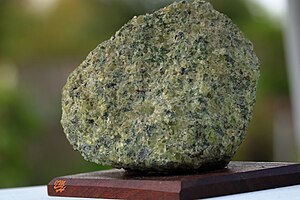Ultramafic rocks(also referred to asultrabasic rocks,although the terms are not wholly equivalent) areigneousandmeta-igneous rocks with a very lowsilicacontent (less than 45%), generally >18%MgO,highFeO,lowpotassium,and are usually composed of greater than 90%maficminerals(dark colored, highmagnesiumandironcontent). TheEarth's mantleis composed of ultramafic rocks. Ultrabasic is a more inclusive term that includes igneous rocks with low silica content that may not be extremely enriched in Fe and Mg, such ascarbonatitesandultrapotassic igneous rocks.

Intrusive ultramafic rocks
editIntrusive ultramafic rocks are often found in large, layeredultramafic intrusionswheredifferentiatedrock types often occur in layers.[1]Suchcumulaterock types do not represent the chemistry of the magma from which they crystallized. The ultramafic intrusives include thedunites,peridotitesandpyroxenites.Other rare varieties includetroctolitewhich has a greater percentage of calcic plagioclase. These grade into theanorthosites.Gabbroandnoriteoften occur in the upper portions of the layered ultramafic sequences.Hornblenditeand, rarelyphlogopite,are also found.
Volcanic ultramafic rocks on Earth
editVolcanicultramafic rocks are rare outside of theArchaeanand are essentially restricted to theNeoproterozoicor earlier.Subvolcanicultramafic rocks anddykespersist longer, but are also rare. There is evidence of ultramafic rocks elsewhere in the solar system.
Examples includekomatiite[2]andpicritic basalt.Komatiites can be host tooredeposits ofnickel.[3]
Ultramafic tuff
editUltramafictuffis extremely rare. It has a characteristic abundance ofolivineorserpentineand a scarcity or absence offeldsparandquartz.Rare occurrences may include unusual surface deposits ofmaarsofkimberlitesin thediamondfields of southern Africa and other regions.
Ultrapotassic ultramafic rocks
editTechnicallyultrapotassic rocksandmeliliticrocks are considered a separate group, based on melting model criteria, but there are ultrapotassic and highly silica-under-saturated rocks with >18% MgO which can be considered "ultramafic".
Ultrapotassic, ultramafic igneous rocks such aslamprophyre,lamproiteandkimberliteare known to have reached the surface of the Earth. Although no modern eruptions have been observed, analogues are preserved.
Most of these rocks occur asdikes,diatremes,lopolithsorlaccoliths,and very rarely, intrusions. Most kimberlite and lamproite occurrences occur asvolcanicand subvolcanic diatremes andmaars;lavas are virtually unknown.
Vents ofProterozoiclamproite (Argyle diamond mine), andCenozoiclamproite (Gaussberg,Antarctica) are known, as are vents ofDevonianlamprophyre (Scotland). Kimberlite pipes in Canada, Russia and South Africa have incompletely preservedtephraandagglomeratefacies.
These are generallydiatremeevents and as such are not lava flows although tephra andashdeposits are partially preserved. These represent low-volumevolatile melts and attain their ultramaficchemistryvia a different process than typical ultramafic rocks.
Metamorphic ultramafic rocks
editMetamorphismof ultramafic rocks in the presence ofwaterand/orcarbon dioxideresults in two main classes of metamorphic ultramafic rock;talc carbonateandserpentinite.
Talc carbonation reactions occur in ultramafic rocks at lowergreenschistthrough togranulitefacies metamorphism when the rock in question is subjected to metamorphism and the metamorphic fluid has more than 10% molar proportion of CO2(carbon dioxide).
When such metamorphic fluids have less than 10% molar proportion of CO2,reactions favor serpentinisation, resulting inchlorite-serpentine-amphiboletype assemblages.
Distribution in space and time
editThe majority of ultramafic rocks are exposed inorogenicbelts, and predominate inArchaeanandProterozoicterranes. Ultramafic magmas in thePhanerozoicare rarer, and there are very few recognised true ultramafic lavas in the Phanerozoic.[citation needed]
Many surface exposures of ultramafic rocks occur inophiolitecomplexes where deep mantle-derived rocks have beenobductedontocontinental crustalong and abovesubductionzones.
Soil and regolith
editSerpentine soilis a magnesium rich, calcium, potassium and phosphorus poor soil that develops on theregolithderived from ultramafic rocks. Ultramafic rocks also contain elevated amounts of chromium and nickel which may be toxic to plants. As a result, a distinctive type ofvegetationdevelops on these soils. Examples are the ultramaficwoodlandsand barrens of theAppalachianmountainsandpiedmont,the "wetmaquis"of theNew Caledonia rain forests,and the ultramaficforestsofMount Kinabaluand other peaks inSabah,Malaysia.Vegetation is typically stunted, and sometimes includesendemicspecies adapted to the soils.
Often thick,magnesite-calcretecaprock,lateriteandduricrustforms over ultramafic rocks intropicalandsubtropicalenvironments. Particularfloralassemblages associated with highly nickeliferous ultramafic rocks are indicative tools formineral exploration.
Weathered ultramafic rocks may formlateritic nickel ore deposits.[4][5]
Other celestial bodies
editIo
editUltramafic lava may have been detected onIo,a moon ofJupiter,becauseheat-mappingof Io's surface found ultra-hot areas with temperatures in excess of 1,200 °C (2,190 °F). Themagmaimmediately below these hot spots is probably about 200 °C (360 °F) hotter, based on surface-to-subsurface temperature differences observed for lava on Earth. A temperature of 1,400 °C (2,550 °F) is thought to indicate the presence of ultramafic magma.[6][better source needed]
Mercury
editSee also
editReferences
edit- ^Ballhaus, C.G. & Glikson, A.Y., 1995,Petrologyof layered mafic-ultramafic intrusions of the Giles Complex, westernMusgrave Block,central Australia.AGSO Journal, 16/1&2: 69-90.
- ^Hill R.E.T,Barnes S.J.,Gole M.J., and Dowling S.E., 1990. Physicalvolcanologyof komatiites; A field guide to the komatiites of the Norseman-WilunaGreenstone Belt,EasternGoldfields Province,Yilgarn Block,Western Australia.,Geological Society of Australia.ISBN0-909869-55-3
- ^Lesher, C.M., Arndt, N.T., and Groves, D.I., 1984, Genesis of komatiite-associated nickelsulfidedeposits atKambalda,Western Australia: A distal volcanic model, in Buchanan, D.L., and Jones, M.J. (Editors), Sulphide Deposits in Mafic and Ultramafic Rocks,Institution of Mining and Metallurgy,London,p. 70-80.
- ^Golightly, J.P. (1981): Nickeliferous Laterite Deposits.Economic Geology75, pp. 710–735
- ^Schellmann, W. (1983):Geochemicalprinciples of lateritic nickel ore formation. Proceedings of the 2. International Seminar on Lateritisation Processes,São Paulo,pp. 119–135
- ^"Space Volcanoes".Horizon.No. Series 54, Episode 6. BBC. 7 July 2018.Retrieved6 March2019.
- ^Charlier, B.; Grove, T.L.; Zuber, M.T. (2013)."Phase equilibria of ultramafic compositions on Mercury and the origin of the compositional dichotomy"(PDF).Earth and Planetary Science Letters.363:50–60.Bibcode:2013E&PSL.363...50C.doi:10.1016/j.epsl.2012.12.021.